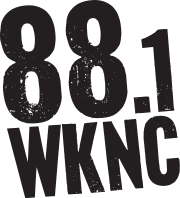WKNC-FM
WKNC-FM (88.1 FM) is North Carolina State University's student-run, non-commercial radio station broadcasting from Raleigh, North Carolina in the United States. Broadcasting with an effective radiated power of 25,000 watts,[1] its signal covers much of the Research Triangle and outlying areas. The station is operated as part of the Department of Student Media at N.C. State and students hold all roles from DJ to general manager. The primary weekday format is indie rock, with specialty shows and other music genres featured during the evenings and weekends.
 | |
| City | Raleigh, North Carolina |
|---|---|
| Broadcast area | Raleigh-Durham, North Carolina |
| Frequency | 88.1 (MHz) (HD Radio) |
| Programming | |
| Format | Analog/HD1:Variety HD2:Modern Rock HD3:Dance Music |
| Ownership | |
| Owner | North Carolina State University |
| History | |
| First air date | October 9, 1966 |
| Technical information | |
| Facility ID | 49160 |
| Class | C3 |
| Power | 25,000 watts |
| HAAT | 79 meters (259 ft) |
| Transmitter coordinates | 35°47′15″N 78°40′14″W |
| Links | |
| Webcast | www |
| Website | www |
Programming
WKNC's programming is divided into four main formats: Daytime Rock (primarily indie rock), Afterhours (electronic/techno music), Underground (hip-hop), and Chainsaw Rock (heavy metal). The "Local Lunch" airs weekdays from 12pm to 1pm, during which only North Carolina artists are played.
WKNC airs many specialty shows including Mystery Roach (progressive, fusion, psychedelic, garage, and noise from the 1960s and 1970s) and Geet Bazaar (South Asian music from India, Pakistan, Bangladesh, and others). Other current specialty music genres include soul and R&B, A cappella, classic country and western swing, punk rock, post-rock, emo, jazz and Americana. Previous specialty programs have featured classical music, ska, grunge, dance, funk, blues, K-pop, jam band and beach music.
WKNC produces a weekly public affairs show called "Eye on the Triangle," which focuses on current events and culture in the Research Triangle. The station also broadcasts all NC State Wolfpack women's basketball games, NC State hockey road games and men's baseball games from the Wolfpack Sports Network.
Audio podcasts of "Eye on the Triangle" and WKNC interviews are available via iTunes.
Each year since 2004, WKNC also holds a benefit concert named the Double Barrel Benefit. The two-night concert series bring in North Carolina based bands in order to raise additional funds for the station.[2]
History
- August 31, 1922 – WLAC-AM at North Carolina State College became the first radio station in eastern North Carolina and the third to be licensed in the entire state.
- October 16, 1922 – WLAC's first broadcast featured guest speaker Josephus Daniels, former secretary of the U.S. Navy and owner of the Raleigh News & Observer. Daniels made the ironic prediction: "Nobody now fears that a Japanese fleet could deal an unexpected blow on our Pacific possessions...Radio makes surprises impossible."
- October 29, 1923 – No application for renewal was filed and WLAC was deleted from the FCC records.
- 1944 – A group of engineering students establish WOLF (the mascot of NCSU is the Wolfpack) as a carrier current station for on-campus listeners.
- 1945 – The station's call letters were changed to WNCS (W-North Carolina State) and the station was recognized by the Student Publications Authority. With university support, a permanent home for the station was established on campus.
- 1947 – The call letters were changed again to WVWP (W-Voice of the Wolf Pack) as the station experimented with broadcasting sporting events.
- 1948 – The station broadcast all home basketball games.
- April 1952 – The FCC shut the station down for over-radiation of its signal. The station resumed operations in September 1952.
- 1958 – A final call letter change from WVWP to WKNC 580 AM. Call letters came after a big victory over UNC: "We Killed North Carolina."
- October 9, 1966 – WKNC 580 AM became WKNC 88.1 FM. The 10 watt transmitter expanded the coverage area from on-campus residence halls to much of the surrounding city. WKNC aired a mix of folk, jazz, and classical music at the time.
- 1972 – The station moved into studios in the University Student Center, and a guyed 30 foot antenna tower was built atop the University's library.
- 1974 – Transmitter power increased to 1,000 watts. Format changed to a progressive rock style, but continued to feature top-40, jazz, and soul.
- early 1980s – The station known as Rock 88, moved into a hard rock/heavy metal format and gained praise as one of the top college stations in the nation.
- 1984 – Effective Radiated Power increased to 3,000 watts, expanding coverage to a 40-mile radius. An 80-foot self-supporting tower replaced the guyed mast.
- 1991 – WKNC moved into its current studios in the Student Center Annex (later named the Witherspoon Student Center).
- 1997 – WKNC began its webcast.
- late 1990s & early 2000s – The format changed from a hard rock format to a wider blend of music focusing on independent and non-top-40 artists.
- 2003 – Effective Radiated Power increased to 25,000 watts, making WKNC one of the most powerful college radio stations in America.
- 2011 – Pulse of the Pack sports-talk radio segment begins
- October 9, 2016 – Broadcasting begins in HD Radio to commemorate the station's 50th anniversary at 88.1 FM
- August 2018- Cliff Jenkins takes over as Indie Rock Music Sheriff
- May 3, 2019 WKNC Adds WKNC HD3 sister NC State online station WolfBytes Radio Which broadcasts a Dance Music Format
References
- FM Query Results – Audio Division (FCC) USA
- Grayson Haver Currin (16 December 2015). "WKNC keeps Raleigh-and-Carrboro format for Double Barrel Benefit, adds hip-hop". Indy Week. Retrieved 20 February 2016.
External links
- WKNC in the FCC's FM station database
- WKNC on Radio-Locator
- WKNC in Nielsen Audio's FM station database

